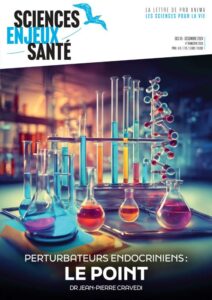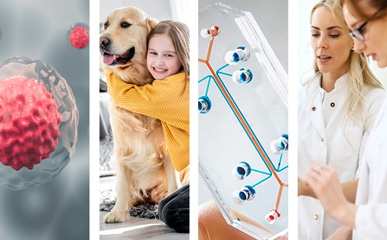
From raw data to NAM-based information, 2025 Trends for Organoids, SOT Award Recipient, Merck x HUB Organoids and more
News on non-animal methods
JANUARY 27 - 31, 2025NEWS, REPORTS & POSITION STATEMENTS
1. Workshop report : State of the science on assessing DNT using NAMs
Co-organized by University of Maryland’s Joint Institute for Food Safety and Applied Nutrition (JIFSAN) and the U.S. Food and Drug Administration’s (FDA) Human Foods Program), on November 2023, conveying experts from international organizations, governmental agencies, industry, and academia, the workshop aimed to explore the transition from traditional in vivo tests to innovative new approach methods (NAMs) in developmental neurotoxicity (DNT) testing.
Emphasizing the heightened vulnerability of the developing human brain to toxic exposures and the potential of NAMs to provide more ethical, economical, and scientifically robust alternatives to traditional testing, the workshop discussed various NAMs for DNT, ongoing challenges and the capabilities and limitations of current DNT NAMs, outlining critical next steps in advancing the field of DNT testing.
2. The long way from raw data to NAM-based information : Overview on data layers and processing steps
Data management, processing, and interpretation are important elements of a comprehensive NAM definition. As NAMs are increasingly standard components of the spectrum of toxicological test methods used for risk assessment, awareness of the significance of data processing steps in NAMs is crucial for building trust, ensuring acceptance, and fostering the reproducibility of NAM outcomes.
In a recent article published in ALTEX, Blum et al. aim to give an overview of the most important data levels to be considered during the development and application of a NAM, illustrating data processing and evaluation steps between data levels and in the data processing pipeline that is often highly complex.
3. 2025 Trends : Organoids
Organoids exhibit various structural and functional characteristics of their in vivo counterpart organs and have led to many new cancer models. According to a report by The Insight Partners, the organoid market is expected to reach $15.01 billion in 2031, a CAGR of 22.1% over 2023’s $3.03 billion.
The upcoming year may witness significant advances in several key areas related to human organoid models in addition to their potential to serve as a bridge and a more cost-effective alternative to animal toxicity testing : improving drug development by incorporating human diversity and modeling disease and orphan disease drug screening ; patient organoids for personalized medicine ; developing validated, trustworthy models… GEN talked to several R&D experts to get a sense of where the organoid market might be headed in the next few years.
INTERVIEWS, NOMINATIONS & AWARDS
4. Nicole Kleinstreuer : 2025 SOT Award Recipient
Among the recipients of the 2025 SOT Award, Nicole Kleinstreuer, Director of NICEATM (NTP Interagency Center for the Evaluation of Alternative Toxicological Methods, NIH — US), received the “Enhancement of Animal Welfare Award”.
“I have dedicated much of my career to advancing human-biology based methods that provide more rapid, relevant, and ethical approaches to better public health protection and insights into disease mechanisms. None of the work that I do would be possible without the tremendous contributions of NICEATM ICCVAM and all our collaborators across the scientific community.” Nicole Kleinstreuer.
The awardees will be honored during the 2025 SOT Annual Meeting and ToxExpo, March 16 – 20, 2025.
Read the SOT award announcement
5. £100,000 NC3Rs award to ‘Stroke-on-a-chip’ model from University of Strathclyde
The University of Strathclyde (Glasgow) has been awarded £100,000 from the NC3Rs to fund a 36-month PhD studentship to help develop a human ‘stroke-on-a-chip’ model to replace animal testing in research. The project’s Principal Investigator Dr Hilary Carswell and Co-Investigators Dr Michele Zagnoni and Professor Claire Gibson will work with the PhD student to adapt an in-house-developed microfluidics model to use human-derived stem cells instead of rodent cell cultures.
Thousands of prospective drugs have shown neuroprotective effects in animal stroke models but have failed in clinical trials. The humanised microfluidics model addresses this gap by better mimicking human pathophysiology, offering the dual benefit of sparing animal lives and improving the predictive value of preclinical stroke research.
TOOLS, PLATFORMS, CALLS
6. MPS World Summit 2025 : Travel Grants from the EPAA and the ECEAE
The MPS (Micro Physiological Systems) World Summit 2025, will take place in June in Brussels. Costs linked to participation in such high-profile international meetings bringing together world-class scientists working on alternatives to animal testing may prevent students with promising work or young scientists at the beginning of their career from attending these events.
The EPAA and the ECEAE support and offer grants to attend the MPS World Summit 25to university students and early-career researchers with a strong interest in animal-free science.
- From the EPAA : 2 full grants of €1 000 covering event registration fees for the student/young scientist, travel and accommodation fees, based on the expense receipts. Application deadline : 14/02/2025
Read more about the eligibility and submit an application to the EPAA
- From the ECEAE : 3 travel grants. Each grant includes €1,000 for travel expenses and a waiver of the registration fee for the summit. Application Deadline : 31/03/2025.
Read more about the eligibility and submit an application to the ECEAE
7. Creating training opportunities in NAMs for early-career researchers
As research and testing methods rapidly advance, there is a pressing need to train the next generation of scientists in New Approach Methodologies (NAMs) ‑human-specific, non-animal methods- as critical tools to reduce animal use, improve clinical translation, and solve public health challenges.
Aiming to address this need, the Physicians Committee for Responsible Medicine hosted, in May 2024 in Washington DC, its third biennial Summer Immersion on Innovative Approaches in Sciences, where early-career researchers from around the world gained hands-on experience with NAMs, through workshops, poster presentations, technology demonstrations, case studies, and networking sessions. Proceedings and key recommendations, such as investing in training events and institutional programs, have been published in NAM Journal highlighting the vital role of NAMs in advancing impactful, translatable research across the translational science spectrum.
INDUSTRY, BIOTECH & PARTNERSHIPS
8. HUB Organoids is now part of Merk
The Life Science business of Merck KGaA, Darmstadt, Germany, a leading science and technology company, announced the closing of the transaction to acquire HUB Organoids Holding B.V. (HUB). The acquisition, which closed on December 23 2024, is a strategic step aligned with the company’s commitment to providing novel next-generation biology solutions to the life science industry, specifically by enabling wider access to HUB’s technology for faster and more effective drug development.
“HUB’s advanced technology, combined with our cell culture expertise and broad portfolio, makes us a valuable resource for researchers looking to leverage the power of 3D cell culture to understand the impact of drug response earlier in the development process.” said Jean-Charles Wirth, Head of Science & Lab Solutions for the Life Science business of Merck KGaA.
SCIENTIFIC DISCOVERIES & PROTOCOLS
9. Repetitive injury induces phenotypes associated with Alzheimer’s disease
Infection with herpes simplex virus type 1 (HSV‑1) in the brains of APOE4 carriers increases the risk of Alzheimer’s disease (AD). Researchers previously found that latent HSV‑1 in a 3D in vitro model of APOE4-heterozygous human brain tissue was reactivated in response to neuroinflammation caused by exposure to other pathogens. Because traumatic brain injury also causes neuroinflammation, it was surmised that brain injury might similarly reactivate latent HSV‑1.
In a new article published in Science Signaling, Cairns et al. examined the effects of one or more controlled blows to their human brain model in the absence or presence of latent HSV‑1 infection.After repeated, mild controlled blows, latently infected tissues showed reactivation of HSV‑1 ; the production and accumulation of β amyloid and phosphorylated tau and activated gliosis, which is associated with destructive neuroinflammation.
10. Immunocompetent human kidney on-a-chip model to study renal inflammation
Kidney damage and dysfunction is an emerging health issue worldwide resulting in high morbidity and mortality rates. Numerous renal diseases are recognized to be driven by the immune system. Despite this recognition, the development of targeted therapies has been challenging as knowledge of the underlying mechanism and complex interactions remains insufficient.
This study describes the establishment of a human immunocompetent 3D in vitro co-culture model of the proximal tubule (PT) in a novel high-throughput microfluidic platform that can be used to fill the gap that currently exists to study, preclinically, renal functionality and inflammatory processes in health and disease.
11. Fundable frontiers in medical research : Spatial omics
In a short article in the More Impact Newsletter, Scott Wagers explains why spatial omics is one of the biggest medical research frontiers, bringing disease subclassification to a new level and better dissecting mechanisms.
Based on several studies, the article gives a glimpse of the future with spatial omics, enabling researchers to get more fine-grained on targeting therapies, finding explanations for the lack of response to therapy in subpopulations, and identifying mechanisms that were previously obscured by the loss of spatial information.


